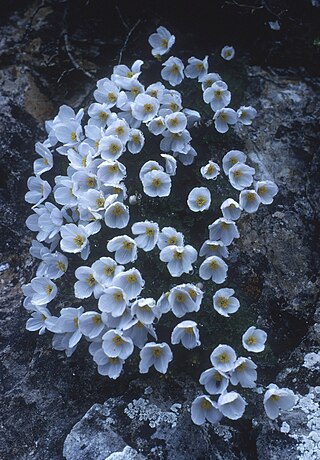
Ranunculaceae is a family of over 2,000 known species of flowering plants in 43 genera, distributed worldwide.
Sterculiaceae was a family of flowering plant based on the genus Sterculia. Genera formerly included in Sterculiaceae are now placed in the family Malvaceae, in the subfamilies: Byttnerioideae, Dombeyoideae, Helicteroideae and Sterculioideae.

James Drummond was an Australian botanist and naturalist who was an early settler in Western Australia.

Máire Drumm was the vice-president of Sinn Féin and a commander in Cumann na mBan. She was assassinated by Ulster loyalists while recovering from an eye operation in Belfast's Mater Hospital.

Sageretia henryi is a species of flowering plant in the family Rhamnaceae. It is a woody shrub reaching a height of 2.5 metres, sometimes although growing to the size of a small tree. It has green, ovate leaves and yellow or white flowers. The shrub is found in mountain thickets and dense forests of China in the Gansu, Guangxi, Guizhou, Hubei, Hunan, Shaanxi, Sichuan, Yunnan S Zhejiang.

Sageretia gracilis is a species of flowering plant in the family Rhamnaceae. It is a shrub with slightly shiny dark green leaves and yellow-green flowers. It grows in thickets or forests in valleys and on mountains around 1200 to 3400 meters of W Guangxi, east and south east Xizang, and Yunnan, China.
Angylocalyx talbotii is a species of flowering plant in the family Fabaceae. It is found in Cameroon and Nigeria. Its natural habitat is subtropical or tropical moist lowland forests. It is threatened by habitat loss.
Buxus nyasica is a species of plant in the family Buxaceae. It is endemic to Malawi. It is threatened by habitat loss.
Grossera elongata is a species of plant in the family Euphorbiaceae. It is endemic to Príncipe.
Aphanopetalum clematideum is a species of twining shrub or vine in the family Aphanopetalaceae. It grows in the Geraldton Sandplains region of Western Australia. It grows to approximately 5 m high from July to October, and is green-cream/green-yellow in color.

Helicteroideae is a subfamily of the family Malvaceae. Some taxonomists have place genera in Helicteroideae in distinct families Durionaceae and Helicteraceae.

Boswellia dalzielii is a tree species in the family Burseraceae found in Africa. The bark of this plant is used in traditional medicines.

Mansonia mosquitoes are large black or brown mosquitoes with sparkling on their wings and legs. They breed in ponds and lakes containing certain aquatic plants, especially the floating type like Pistia stratiotes and water hyacinth. The eggs are laid in star-shaped clusters on the undersurface of leaves of these plants. The larvae and pupae are found attached to the rootlets of these plants by their siphons. They obtain their air supply from these rootlets. When preparing to transform into adults, these pupae come to the surface of water and the fully formed adults emerge and escape. The control of Mansonia mosquitoes accomplished by removal or destruction of the aquatic host plants by herbicides.

Olinia emarginata, the mountain hard pear or berghardepeer in Afrikaans language, is a tree species in the family Penaeaceae. It is native to South Africa and Lesotho.
Althenia australis is a species of aquatic plant in the family Potamogetonaceae. It is found in fresh to brackish waters in Australia. This species has been transferred from Lepilaena.

Asteropyrum is a genus of flowering plants belonging to the family Ranunculaceae.

Paraquilegia is a genus of flowering plants belonging to the family Ranunculaceae.

Mansonia is a genus of flowering plants. It includes five species of large evergreen or deciduous trees. The species are native to tropical Africa and southeastern Asia.

Mansonia altissima is a species of tree native to western and Central Africa. It has the vernacular names of; African black walnut or African walnut.












